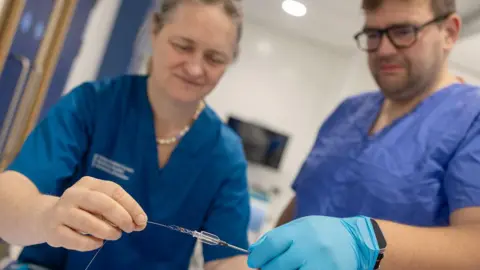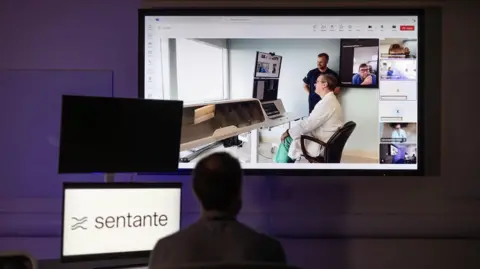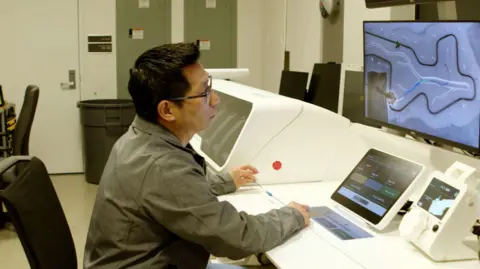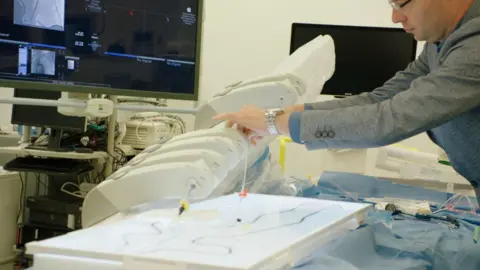Graham FraserBBC Scotland
 University of Dundee
University of DundeeDoctors from Scotland and the US have completed what is believed to be the world's first stroke procedure using a robot.
Professor Iris Grunwald from the University of Dundee performed a remote thrombectomy – removing blood clots after a stroke – on a human cadaver that was donated to medical science.
The professor was at Ninewells Hospital in Dundee, and the body she was operating on with the machine was across town at the university.
Hours later, Ricardo Hanel, a Florida neurosurgeon, used the technology to perform the first transatlantic surgery at his Jacksonville base on a human body in Dundee, more than 4,000 miles (6,400 km) away.
 University of Dundee
University of DundeeThe team called it a potential “game changer” if it is approved for use in patients.
Doctors believe this technology could change the treatment of stroke, as delays in seeing a specialist can directly affect the chances of recovery.
Professor Grunwald said: “It seemed to me that we were witnessing the first glimpse of the future.
“This used to be considered science fiction, but we have demonstrated that every step of the procedure can already be performed.”
The University of Dundee is a global training center for the World Interventional Stroke Federation and the only place in the UK where doctors can operate on cadavers with a fluid that mimics human blood circulating in the vessels.
“This was the first time we were able to perform the entire mechanical thrombectomy procedure on a real human body to show that all steps of the procedure are possible,” said Professor Grünwald.
Juliet Bouverie, chief executive of the charity Stroke Association, told BBC News that the transatlantic procedure was a “wonderful innovation”.
She added: “For too long, people living in remote and rural areas have been denied access to thrombectomy.
“Robotics like this could help balance the inequalities that exist in stroke care in the UK.”
 University of Dundee
University of DundeeIn the experiment, a liquid simulating human blood was used on four different cadavers.
Subjects who donated their bodies to science died within the last three years and were then embalmed.
The procedures in Dundee and Florida were carried out last month using robotics from Lithuanian firm Sentante.
Although remote thrombectomies have previously been performed on silicon modelA 3D printed copy And on an animalIt is believed that this was the first procedure on the human body.
The team now hopes to take part in clinical trials next year.
How does the technology work?
Ischemic stroke occurs when an artery is blocked by a blood clot.
This stops the flow of blood and oxygen to the brain, causing brain cells to lose function and die.
The best treatment is thrombectomy, in which a specialist removes the clot using catheters and wires.
But what happens when a patient cannot get to a specialist who can perform the procedure?
Professor Grunwald said the experiment demonstrated that the robot could be connected to the same catheters and wires that a surgeon would normally use, and a medic with the patient could simply attach the wires.
A surgeon in a different location can then hold and move his own wires, and the robot then performs the exact same movements in real time on the patient to perform the thrombectomy.
The patient will be in the hospital operating room, and the doctor will be able to perform the procedure using the Sentante device anywhere – even at home.
Professor Grünwald and Ricardo Hanel could see x-rays of the body during experiments and monitor progress in real time. The Dundee expert said the training took just 20 minutes.
Technology giants Nvidia and Ericsson were involved in the project to provide connectivity to the robot.
Dr Hanel said: “To move from the US to Scotland with a delay of 120 milliseconds – in the blink of an eye – is truly remarkable.”
 feeling
feeling feeling
feelingThe future of stroke treatment
Professor Grunwald, who received an award from Innovate UK for her work and is also vice-president of the World Interventional Stroke Federation, said there were two main problems with standard thrombectomy: a global shortage of doctors who can do it, and treatment depends on your location.
There are only three places in Scotland where patients can have the procedure: Dundee, Glasgow and Edinburgh. If you don't live there, you'll have to travel.
Professor Grunwald said: “The treatment is very time sensitive.
“For every six minutes you delay, you are 1% less likely to have a good outcome.
“This technology will now provide a new way for you to be independent of where you live – saving valuable minutes when your brain is otherwise dying.”
Public Health Scotland said There were 9,625 ischemic strokes in Scotland last year.
Just 212 – or 2.2% of all patients – had thrombectomies, and 1,045 received drugs to break blood clots.
For the rest of the UK only 3.9% of all stroke patients received thrombectomy in March 2024.
“It's an amazing feeling,” added Edvardas Satkauskas, CEO of Sentante, speaking to BBC News from the company's headquarters in Lithuania.
“Sometimes the future is much closer than we think.”









